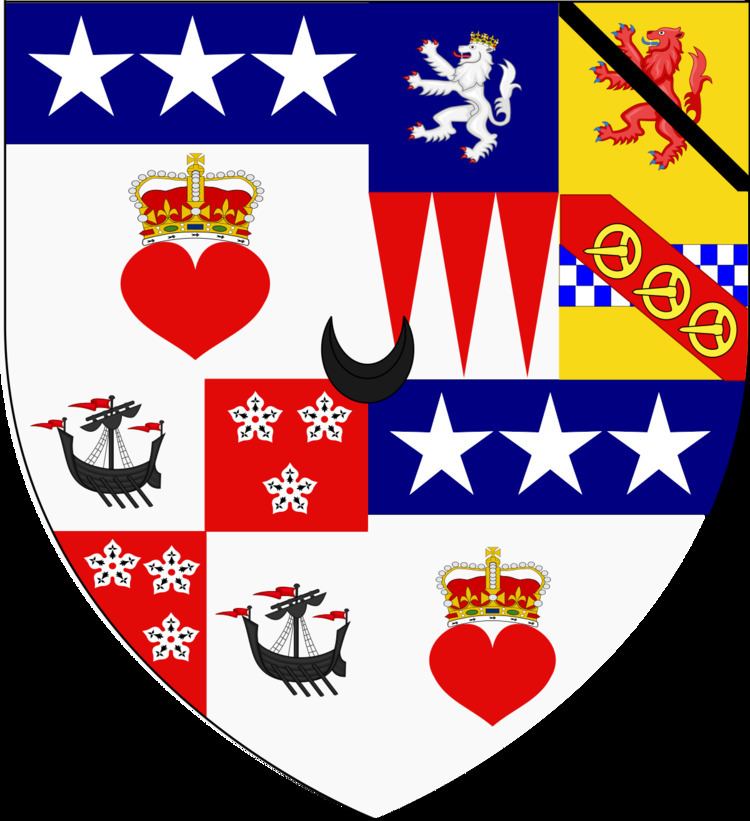 | ||
Earl of Selkirk is a title in the Peerage of Scotland. Its descent is subject to unusual (and unique) provisions.
Contents
History
The title was created on 4 August 1646 for Lord William Douglas, third son of William Douglas, 1st Marquess of Douglas, along with the title Lord Daer and Shortcleuch. On 29 April 1656, the first Earl married Anne Hamilton, 3rd Duchess of Hamilton. In 1660, after the birth of two sons, he changed his surname from Douglas to "Hamilton", and was created Duke of Hamilton for life, as was then a not uncommon practice in Scotland when a peeress in her own right married someone of lesser degree.
On 6 October 1688, during the reign of James VII, the new Duke of Hamilton surrendered his previous titles to the Crown (except Hamilton). They were reconferred on his third (but second surviving) son Charles Douglas, 2nd Earl of Selkirk, who thereby became 2nd Earl of Selkirk, and who also reverted to his original surname of "Douglas". Thus, while the eldest son was to inherit the title of Duke of Hamilton and have his mother's maiden name for surname, the younger son was to inherit his father's dignities and perpetuate the name of Douglas.
This novodamus for this arrangement embodied a unique remainder, the effect of which was that:
- the titles would pass to the heirs male of the 1st Earl's younger sons before the heirs male of his eldest son (who was heir apparent to his mother's Dukedom of Hamilton);
- if the person who would otherwise inherit the title was already Duke of Hamilton (or would inherit that Dukedom at the same time), the titles would pass instead to that Duke's next surviving brother;
- if the titles were ever held by a Duke of Hamilton (either because an Earl of Selkirk succeeded as Duke of Hamilton, or because provision 2 was unable to operate because the heir was a Duke of Hamilton who had no surviving younger brothers), the titles would pass on that Duke's death to his second surviving son;
- if the titles had passed to a younger brother or younger son under provisions 2 or 3, they would then pass to his heirs male on his death; but
- if such a younger son or younger brother's heirs male died out, the title would not pass to his own younger brothers and their heirs male, but would instead revert to the senior male line, with provisions 2 and 3 operating as before.
This remainder is so unusual that a Scottish country dance—Hamilton House—was created around it.
The 2nd Earl died childless in 1739, and his younger brother, John Hamilton, 1st Earl of Ruglen (who had been so created on 14 April 1697), succeeded as 3rd Earl. He outlived his son and heir, and when he died in 1744 the Earldom of Ruglen and its subsidiary titles passed to his daughter Anne Douglas, Countess of March, and on her death in 1748 to William Douglas, 3rd Earl of March (later 4th Duke of Queensberry).
The Earldom of Selkirk and its subsidiary title, being limited to male heirs, passed to Dunbar Hamilton, grandson of Lord Basil Hamilton, sixth son of the 1st Earl. Upon succeeding as 4th Earl, he, like the 2nd Earl, changed his surname to "Douglas". On his death in 1799, he was succeeded by his only surviving son, Thomas Douglas, Lord Daer, as 5th Earl, and he was then succeeded on his death in 1820 by his only son, Dunbar Douglas, Lord Daer, as 6th Earl.
On his death in 1885, the heirs male of the younger sons of the 1st Earl expired. The heir male of the 1st Earl's eldest son was William Douglas-Hamilton, 12th Duke of Hamilton, but under the special remainder (provision 2 above) the titles passed instead to his younger brother, Lord Charles Hamilton, who succeeded as 7th Earl. When he died unmarried in 1886, the titles reverted to his elder brother, who had no further brothers to whom they could pass, and who accordingly succeeded as 8th Earl. When he died without a son in 1895, the Dukedom passed to his fourth cousin, Alfred Douglas-Hamilton, who succeeded as 13th Duke of Hamilton. As he also had no brothers, he also succeeded as 9th Earl of Selkirk.
When he died in 1940, his eldest son, Douglas Douglas-Hamilton, Marquess of Douglas and Clydesdale, inherited the Dukedom, but the Earldom of Selkirk and its subsidiary title passed under the special remainder (provision 3 above) to his second son, Lord George Douglas-Hamilton, who succeeded as 10th Earl.
Upon the death of the 10th Earl in 1994, married but childless, the titles passed (under provision 5 above) to his nephew, Lord James Douglas-Hamilton, second son of the 14th Duke of Hamilton and next brother of Angus Douglas-Hamilton, 15th Duke of Hamilton, who succeeded as 11th Earl. This succession was unsuccessfully challenged by Alasdair Douglas-Hamilton, son of Lord Malcolm Douglas-Hamilton, next brother of the 10th Earl.
The 11th Earl was, at the time of his succession, the Member of Parliament for Edinburgh West, and he disclaimed the titles in order to remain in the House of Commons. He was later elevated to the House of Lords with a life peerage as Baron Selkirk of Douglas, and served as a Member of the Scottish Parliament. His heir (under provision 4 above) is John Douglas-Hamilton, Lord Daer, Master of Selkirk.
Earls of Selkirk (1646)
The heir apparent is the present holder's son John Andrew Douglas-Hamilton, Lord Daer (b. 1978).
